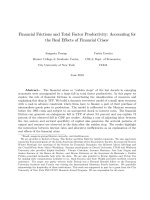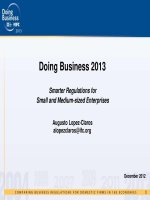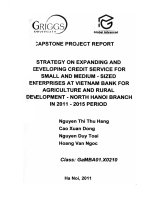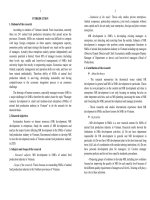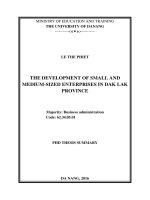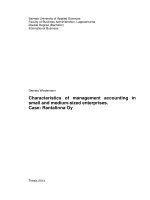Outsoursing and total factor productivity evidence from vietnamese small and medium sized enterprises
Bạn đang xem bản rút gọn của tài liệu. Xem và tải ngay bản đầy đủ của tài liệu tại đây (1.13 MB, 67 trang )
UNIVERSITY OF ECONOMICS
HO CHI MINH CITY
VIETNAM
ERASMUS UNIVERSITY ROTTERDAM
INSTITUTE OF SOCIAL STUDIES
THE NETHERLANDS
VIETNAM – THE NETHERLANDS
PROGRAMME FOR M.A IN DEVELOPMENT ECONOMICS
OUTSOURCING AND TOTAL FACTOR
PRODUCTIVITY: EVIDENCE FROM
VIETNAMESE SMALL AND MEDIUM-SIZED
ENTERPRISES
BY
PHAM THI HOA TIEN
MASTER OF ARTS IN DEVELOPMENT ECONOMICS
HO CHI MINH CITY, December 2017
UNIVERSITY OF ECONOMICS
HO CHI MINH CITY
VIETNAM
INSTITUTE OF SOCIAL STUDIES
THE HAGUE
THE NETHERLANDS
VIETNAM - NETHERLANDS
PROGRAMME FOR M.A IN DEVELOPMENT ECONOMICS
OUTSOURCING AND TOTAL FACTOR
PRODUCTIVITY: EVIDENCE FROM
VIETNAMESE SMALL AND MEDIUM-SIZED
ENTERPRISES
A thesis submitted in partial fulfilment of the requirements for the degree of
MASTER OF ARTS IN DEVELOPMENT ECONOMICS
By
PHAM THI HOA TIEN
Academic Supervisor:
PHAM THI BICH NGOC
HO CHI MINH CITY, December 2017
DECLARATION
This is to certify that this thesis titled “Outsourcing and total factor productivity: evidence
from Vietnamese Small and Medium-sized Enterprises”, which is submitted in fulfillment of
the requirements for the degree of Master of Arts in Development Economics to the Vietnam
Netherlands Program (VNP). The thesis constitutes only my original work and due
supervision and acknowledgement have been made in the text to all material used.
Page i
ACKNOWLEDGEMENT
First, I would like to thank my supervisor - Dr. Pham Thi Bich Ngoc for her support,
advice, and valuable guidance during the thesis process.
Secondly, I would like to thank Dr. Truong Dang Thuy who also gave me useful
advice for my thesis. I also would like to extend my thanks to the Vietnam – Netherlands
program, professors, staffs, and classmates, for their help, encouragement and incredible
knowledge.
Finally, I would like to thank my family and friends, who always unconditionally
supported me in not only the thesis writing but also my whole life.
Pham Thi Hoa Tien
Ho Chi Minh City, December 2017
Page ii
ABBREVIATIONS
SMEs
: Small and Medium-sized Enterprises
R&D
: Research and Development
GDP
: Gross Domestic Product
ROE
: Return on equity
OECD
: Organization for Economic Co-operation and Development
ILSSA
: Labor Studies and Social Affairs
MOLISA
: Ministry of Labor, Invalids and Social Affairs
SSE
: Stockholm School of Economics
GSO
: General Statistic Office
TFP
: Total Factor Productivity
TCT
: Transaction Cost Theory
RBV
: Resource-Based View
RDT
: Resource Dependency Theory
GMM
: Generalized Method of Moment
2SLS
: Two Stages Least Square
CDM
: Crépon, Duguet and Mairesse
IV
: Instrument Variables
OP
: Olley and Parker
LP
: Levinsohn Petrin
OLS
: Ordinary Least Square
FE
: Fixed Effects
RE
: Random Effects
FEM
: Fixed Effects Model
REM
: Random Effects Model
Page iii
ABSTRACT
This study aims to examine the impacts of outsourcing activities on firms total factor
productivity of 4,549 Vietnamese enterprises by using a panel dataset of Small and Mediumsized Enterprises during the period from 2005 to 2013. It is supposed to contribute to existing
empirical, literature by employing the complementarity and substitutability test to investigate
the effect of outsourcing on firms’ total factor productivity. The total factor productivity in
this study is calculated based on Levinsohn Petrin method. Furthermore, the Fixed Effects
with Driscoll Kraay standard error model, which has the advantage of correcting the problem
of autocorrelation and heteroskedasticity is applying to get the better result of outsourcing and
firms’ total factor productivity relationship estimation. The finding proves a significant
positive nexus between outsourcing and firms’ total factor productivity and confirms that
firms spend more on outsourcing will get higher total factor productivity index. These results
are supported by a majority of empirical papers about relationship of outsourcing and total
factor productivity and outsourcing’s theories. From the findings, this study will give some
discussion as well as some policy recommendations for firms to enhance their productivity.
Key words: Vietnamese SMEs, Total factor productivity, Driscoll Kraay.
Page iv
TABLE OF CONTENT
ACKNOWLEDGEMENT ........................................................................................................... i
ABSTRACT............................................................................................................................... iv
TABLE OF CONTENT .............................................................................................................. v
LIST OF TABLES ................................................................................................................... viii
LIST OF FIGURES ................................................................................................................... ix
CHAPTER 1
INTRODUCTION ......................................................................................... 1
1.1 Research problems .......................................................................................................... 1
1.2 Research objectives and questions .................................................................................. 3
1.2.1
Research objectives............................................................................................... 3
1.2.2
Research questions ................................................................................................ 3
1.3 Data and methodology .................................................................................................... 3
1.4 Thesis structure ............................................................................................................... 4
CHAPTER 2
LITERATURE REVIEW .............................................................................. 6
2.1 Outsourcing ..................................................................................................................... 6
2.1.1
Definition of outsourcing ...................................................................................... 6
2.1.2
Theoretical background for outsourcing ............................................................... 7
2.1.2.1
Transaction Cost theory ................................................................................. 7
2.1.2.2
Resource dependency theory ......................................................................... 8
2.1.2.3
Resource-based view theory .......................................................................... 9
2.2 Total factor productivity ............................................................................................... 10
2.2.1
Definition ............................................................................................................ 10
2.2.2
Measurement of total factor productivity ........................................................... 10
Page v
2.3 Empirical studies- outsourcing and TFP ....................................................................... 13
2.4 Conceptual framework .................................................................................................. 14
CHAPTER 3
DATA AND RESEARCH METHODOLOGY .......................................... 16
3.1 Data source ................................................................................................................... 16
3.2 Research model ............................................................................................................. 16
3.2.1
Dependent variable ............................................................................................. 18
3.2.2
Independent variables ......................................................................................... 18
3.2.2.1
Explanatory variables .................................................................................. 18
3.2.2.2
Control variables ......................................................................................... 19
3.3 Methodological approach ............................................................................................. 25
3.4 Econometric approach .................................................................................................. 26
3.4.1
Method for step 1 ................................................................................................ 26
3.4.1.1
3.4.2
Levinsohn Petrin .......................................................................................... 26
Method for step 2 and step 3 ............................................................................... 27
3.4.2.1
Ordinary least square ................................................................................... 27
3.4.2.2
Fixed effects model ..................................................................................... 28
3.4.2.3
Fixed effects model with Driscoll Kraay standard error ............................. 28
CHAPTER 4
EMPIRICAL RESULTS ............................................................................. 30
4.1 Summary statistics and analysis ................................................................................... 30
4.1.1
Data summary ..................................................................................................... 30
4.1.2
Summary statistics .............................................................................................. 33
4.1.3
Model specification and diagnostic testing ......................................................... 35
4.2 Empirical results ........................................................................................................... 36
Page vi
4.2.1
Step 1: Calculate total factor productivity at the firm level ................................ 36
4.2.2
Step 2: The difference between firms with and without outsourcing ................. 37
4.2.3
Step 3: The relationship between outsourcing expenditure and firms’ TFP....... 39
CHAPTER 5
CONCLUSION AND DISCUSSIONS ....................................................... 41
5.1 Main findings ................................................................................................................ 41
5.2 Discussion and suggested policies ................................................................................ 42
5.3 Limitation and potential future research ....................................................................... 44
REFERENCE............................................................................................................................ 46
APPENDIX ............................................................................................................................... 52
Page vii
LIST OF TABLES
Table 3.1 Number observations in dataset 2005-2013 ............................................................. 16
Table 3.2 Variables description ................................................................................................ 23
Table 4.1 Observations by type of firms .................................... Error! Bookmark not defined.
Table 4.2 Observations by type of firms in the period 2005-2013 ........................................... 31
Table 4.3 Firms types with and without outsourcing................................................................ 31
Table 4.4 Firms sizes in the period 2005-2013 ......................................................................... 32
Table 4.5 Descriptive statistics of TFP and other variables ..................................................... 33
Table 4.6: Firms sizes with and without outsourcing ............................................................... 34
Table 4.7 Correlation between variables .................................................................................. 35
Table 4.8: Comparision of OLS, Fixed Effect and LP estimation ............................................ 36
Table 4.9 : Regression results of different TFP between outsourcing firms and none
outsourcing firms ...................................................................................................................... 38
Table 4.10: Regression results of TFP within outsourcing firms ............................................. 39
v
Page viii
LIST OF FIGURES
Figure 2-1 Conceptual Framework ........................................................................................... 15
Figure 3-1 Empirical study stages ............................................................................................ 25
Figure 4-1 Firm sizes with and without outsourcing ................................................................ 34
Figure 4-2 The trend of average total factor productivity from 2005-2013 ............................. 37
Page ix
CHAPTER 1
1.1
INTRODUCTION
Research problems
Outsourcing or the act of contracting out internal activities to foreign suppliers, has
rapidly become a critical approach in the modern economy, especially for manufacturing
firms. Despite being a widely used concept, outsourcing might originate from the late 1970s to
early 1980s as a mean to search for external resources to maximize the firm’s profit (Corbett,
2004). While outsourcing allows the companies to focus on their strength in maintaining and
developing core competencies, it also mitigates the expertise shortage in the less welldeveloped part of company in which that want to outsource (López, 2014).
Through the decades, outsourcing delivers many benefits for business actors such as
reducing cost, improving productivity, enhancing efficiency and concentrating on the core
business operation which lead to lower resource cost and higher quality products (Gilley &
Rasheed, 2000). These advantages of outsourcing were demonstrated through many empirical
studies. For example, outsource information technology helped reducing operational cost (Loh
& Venkatraman, 1995); outsourcing non-core activities would develop service organizations’
capability and flexibility to adapt to the rapidly changing economic environment (Lankford &
Parsa, 1999; Sia, Koh, & Tan, 2008).
Despite many positive aspects, outsourcing also poses serious risks to the firms
(Weidenbaum, 2005). For instance, the unbalance between the actual demands from
outsourcing users and outsourcing contractor’s products, the high product’s price or the
leakage of core competency could potentially affect the firm (Lutchen, 2004). This could be
explained by the inflated information on the vendor’s capability on which they could offer, the
misunderstanding in product’s requirement between the employers and partners, or the lack of
control on the subcontract. Or in another word, the positive impact of outsourcing could be
bounded by their threat (Antonietti, Ferrante, & Leoncini, 2016). While firm’s technology
might be stolen by their outsourcing vendor due to the lack of controlling in legal systems
(Weidenbaum, 2005).
Page 1
In fact, a variety of multinational companies include Apple, Boeing, Nike, Mattel,
Calvin Klein, Kodak are practicing outsourcing successfully (see Quinn and Hilmer (1994);
Doh (2005); and other). For some identical samples, it is worth mentioning Nike, which is not
only a famous footwear company also a successful firm by applying outsourcing. Since they
outsource all their core products to the third party, Nike increased 20 percent in growth rate
and earned 31 percent return on equity (ROE) for its shareholder (Quinn & Hilmer, 1994).
Another outstanding case of using outsourcing efficiently is the cooperation between IBM and
Kodak Eastman in 1989. This pushed Kodak to become a favorite brand in the photography
industry (Dickson, 2011). Implementing outsourcing successfully in the multinational
company is undeniable (Doh, 2005; Landefeld & Mataloni, 2004). However, the effect of
outsourcing on small and medium-sized enterprises (SMEs) remains unclear. This raises the
question: how do the small and medium enterprises apply outsourcing to maximize efficiency
and profits?
From an empirical perspective, outsourcing is studied too broadly. Previous studies
focused on the internal factors that impacts on outsourcing decisions, which are connected to
agency cost theory, resource dependency theory, transaction cost theory (Michael & Michael,
2011). Other researchers measured the impact of outsourcing on productivity. However, most
of the measurement collected information at the industry level and from input-output tables,
rather than firm-level data (López, 2014).Therefore, the number of research studies about the
impact of outsourcing on productivity at firm level is limited. Particularly, for the case of
Vietnam and Organization for Economic Co-operation and Development (OECD) economies
where SMEs contribute over 40% and 55% to overall Gross Domestic Product (GDP),
respectively. Besides, there is lack of research about the outsourcing effect on firm’s
productivity in the context of SMEs in Vietnam.
Therefore, the shortage of outsourcing studies on the firm’s total factor productivity for
the case of Vietnam opens a new line for enquiry. Insights gained from studying outsourcing
in small and medium enterprises provide promising prospects for benefiting Vietnam’s overall
economy in which SMEs are dominant. This study is expected to give a closer look at the
Vietnamese SMEs’ total factor productivity using the Petrin et al. (2004) approach. Besides
Page 2
that, this study also investigates how outsourcing impact SMEs’ total factor productivity.
Moreover, the impact of outsourcing on firms’ productivity is analyzed under the effect of
other fundamental factors such as labor force, capital, technology, innovation, and other.
Therefore, this study aims to contribute to the existing literature by adding some
perspectives to empirical evidence to fully understanding the impact of outsourcing and other
factors on SMEs’ total factor productivity. The result may help the policymakers in deciding
appropriate agenda for supporting outsourcing to obtain the target productivity.
1.2
Research objectives and questions
1.2.1 Research objectives
The primary purpose of this study is to investigate the effect of outsourcing on firms
total factor productivity in the case of Vietnamese small and medium-sized enterprises during
the period of 2005 to 2013.
1.2.2 Research questions
These following questions will be answered to deal with this objective:
(1) Do firms with outsourcing activities have higher total factor productivity?
(2) For Vietnamese SMEs with outsourcing activities, does expenditure outsourcing
positively effect on total factor productivity?
1.3
Data and methodology
This study employs the data from Small and Medium Enterprises (SMEs) of Vietnam
(2005-2013). These surveys are conducted every two years by the collaboration of educational
organizations and government agencies: Stockholm School of Economics (SSE), Department
of Economics- the University of Copenhagen, the Institution of Labor Studies and Social
Affairs (ILSSA) in the Ministry of Labor, Invalids and Social Affairs (MOLISA). Ten
Vietnamese provinces or cities are included in the survey project: four cities or provinces in
the North (Ha Noi, Ha Tay, Hai Phong, Phu Tho); four provinces in the central (Khanh Hoa,
Nghe An, Lam Dong, Quang Nam) and two cities or provinces in the south (Long An, Ho Chi
Minh). The survey is completed by containing a sample of 2500 firms, in which 8% are
Page 3
repeated from the previous survey. For firms who do not respond or not in operation, data is
replaced, these numbers account for 20% data. Thus, data is considered represented for the
Vietnamese SMEs population. In addition, data used in this study ends in 2013 because the
dataset of the 2015 year was not published at the time this study was completed.
After unbalanced panel data is obtained, firms total factor productivity will be
calculated depend on the basic production function model Cobb Douglass. This study employs
Petrin et al. (2004) method to solve the problem of endogeneity in error term. The results of
TFP for each firm will be used as dependent variables to run the regression with the
outsourcing variables and control variables in the Ordinary Least Squares (OLS) model, Fixed
effects (FE) model, Fixed effects (FE) with Discroll and Kraay standard error to analyse their
relationship as well as their interactions. The results of the fixed effects with Discroll and
Kraay standard error estimation is taken as the key results. In the meantime, OLS model is
also used as a comparison result according to previous studies.
1.4
Thesis structure
This study consists of five chapters.
Chapter 1: Introduction
This section provides the research motivation and overall information about this study.
Chapter 2: Literature review
This chapter presents the literature review, which covers theoretical background and empirical
review.
Chapter 3: Research methodology
This chapter offers research methodology, which describes the empirical model and estimation
method.
Chapter 4: Research results
This chapter presents the statistic description, regression result, and statistical analysis.
Chapter 5: Conclusions and discussion
Page 4
This chapter summarizes the conclusion, the implication, the limitation, and the further
research.
Page 5
CHAPTER 2
LITERATURE REVIEW
In this chapter, the literature framework of this study consists of four main points. The
first part provides some definitions and theoretical background of outsourcing. The definition
and measurement of total factor productivity will be introduced in the second part. The third
part will present some empirical studies about the relationship between outsourcing and total
factor productivity. The final part contains the conceptual framework of the study.
2.1
Outsourcing
2.1.1 Definition of outsourcing
There are a variety of definitions of outsourcing in previous studies. In the study of
Loh and Venkatraman (1995) about information technology, “outsourcing” was defined as
“important input from outside supplier in the physical or human resources relate to specific
components of the information technology structure of buyer”. Another definition of
outsourcing from the study of Kotabe (2004) was the supply of the finished product or
component product from vendor independent to the buyer. Lei and Hitt (1995) define
outsourcing as the reliance of the firm on resources and component from external for firm’s
value-added. In another study of Penc (2002) outsourcing was a perception of management in
which use the potential external partner to fulfill for the limited resources of the enterprise by
using a wide range of contemporary management or temporary contract. This concept was
usually applied in the context of small and medium-sized enterprises due to its immanent
resource shortages. In another definition of Simchi-Levi, Kaminsky, and Simchi-Levi (2004),
outsourcing was considered as semi-finished products, finished products or kind of services
which are purchased from a partner outside the company instead of produce internally.
However, the broadness of these terms loses certain analytical leverage to understanding the
nuances of what is being understood (Gilley & Rasheed, 2000).
Outsourcing is not simply a procurement decision, outsourcing is presented as a
“decision to reject the internalization of activity” according to Gilley and Rasheed (2000).
Outsourcing was classified in two ways: abstention and substitution. First, in the abstention
outsourcing, outsourcing raised when goods or services were purchased from outside firm;
Page 6
however, those were not produced internally in the previous. The abstention-based
outsourcing was considered as a type of outsourcing and distinguished from purchasing
activity due to good or service outsourced only was internalized within the managerial and
financial capabilities of the firm in the past. Second, in the substitution outsourcing, the former
internal activities were substituted by the external resource from purchasing. This kind of
outsourcing was recognized as vertical disintegration, which eliminated the participation of
firm in production stages. In general, both types of outsourcing imitated the decision of
company on rejecting the internalization, and the outsourcing could be separated with a typical
transaction by the capacity of a firm to implement outsourced activities by itself.
In this research, we employ the concept of Penc (2002)which was developed by
Matejun (2010) to apply to small and medium-sized enterprises; outsourcing is defined as
contracting out their activities to external partner due to its shortages of resources however
still focus on their strategies and core competencies.
2.1.2
Theoretical background for outsourcing
There were three fundamental theories that dominate outsourcing research: transaction
cost theory (TCT), resource-based view (RBV), and resource dependency theory (RDT).
These theories are elaborated to answer why firms need to terminate in-house to transfer to
outside services (Gerbl, McIvor, & Humphreys, 2009). These theories were one of the most
influential ones in nexus with outsourcing. However, a significant limitation of TCT, RDT,
and RBV is that these theories were mainly based on economic rationale (McIvor, 2009). The
existent of theories help to explain the reason: why do firms terminate in-house operations in
favor of outside services?
2.1.2.1 Transaction Cost theory
Transaction cost theory was a primary outsourcing theory, which was initiated by
Coase (1937) and developed by Williamson (1979). This theory specified the conditions,
which influenced the decision of an organization to manage itself internally (within its
boundaries) or externally (i.e., outsourcing) (Gerbl et al., 2009).
Page 7
Transaction cost according to Gurbaxani and Whang (1991) was the cost of "using a
market” containing operational costs (search cost, selection cost, bargaining cost) and
contractual costs (writing, monitoring and enforcing a contract, coordinating cost. All
activities of firms were based on the balance between transaction cost and production
economics; however, the decision of firms for “make-or-buy” was decided based on
economizing of transaction costs (Williamson, 1985). Besides, transaction costs were affected
by three factors: conditional asset specificity supporting the transaction, the level and kind of
uncertainty rounding the transaction and the frequency of transaction. In which, asset
specificity was seen as critical to transaction since it had a substantial impact on the selection
of governance structures (Riordan & Williamson, 1985; Williamson, 1989).
There were two main behavioral assumptions were studied for this theory: bounded
rationality (the experience of uncertainty from various sources in transacting, complex
contracts were necessary to one degree or another Williamson (1989)) and opportunism (for
the economic actors tend to self-interest-seeking, which created the environment for
developing guile. Since it took a high cost to refine complex contracts, which are necessarily
incomplete, thus opportunism added uncertain behavior to contractual relationships to set the
stage for ex-post performance problems. Therefore, when combined bounded rationality with
opportunism, the organization would experience the complicated problems with uncertain
complexity. With two behavioral assumptions, the problem of organization was dealing with
economizing organizational transaction on bounded rationality while protecting them against
the hazards of opportunism (Williamson, 1985).
Consequently, transaction cost theory advised business actors to keep processes that
were highly specific in-house, as the market transaction costs for communication and
agreement were too high to make outsourcing a viable alternative (Gerbl et al., 2009).
2.1.2.2 Resource dependency theory
The assumption about resource dependency theory is firms seek the opportunities to
enhance their power (Pfeffer & Salancik, 1978; Ulrich & Barney, 1984). Therefore, before the
lack of resources firm could get the needed resources, they had to try to set up the relationship
Page 8
with powerful firms. As a result, firms changed their structure and strategies to purchase the
external resources (Ulrich & Barney, 1984). Resource dependency theory was also a useful
way to examine the relationship between outsourcing decision of firm and their abilities to
utilize resources from outside environment (Yuchtman & Seashore, 1967).
Resource dependency theory revealed that to gain advantage from outsourcing, the
economic actors should adjust their strategy to have strong processes and outsource from the
weaker vendor (Teng et al., 1995). Therefore, firms could access the balancing power through
resource accessibilities, potential supplier number, switching supplier’s cost (Teng et al.,
1995).
2.1.2.3 Resource-based view theory
The third fundamental outsourcing theory was the resource-based view, this theory
supplemented for transaction cost theory and resource dependency theory by emphasizing the
firm’s resource accumulation (Penrose, 1959; Wernerfelt, 1984). Firms got the sustained
competitive advantage from external resources, which was value, imperfectly imitable, nonsubstitutable in competing for firm resources (Arnold, 2000; Barney, 1991). Outsourcing
helped to solve the problem of constraint by maintaining current resources and enhance
strategic affordances (Grant, 1991; Teng et al., 1995). In this case, the resource-based view
theory demonstrated that the competitive advantage of firm come from owning the “difficultto-replicate” resources such as having loyal customers, good reputation, and competent
employees (Lovallo & Mendonca, 2007). The competitive advantages of firm come from core
competency, its marginal impact did not underline sustainable competitive advantage, which
made it appropriate for outsourcing (Arnold, 2000; McIvor, 2009). In this way, the resourcebased view theory related to internal strategy’s activities which pertained to competitors
versus external arrangement (McIvor, 2009).
Page 9
2.2
2.2.1
Total factor productivity
Definition
Productivity was merely defined as the efficiency of production or how much output
could be created from given set of input through production process (Syverson, 2011). Thus,
productivity was the ratio of output and input. Productivity was also a typical indicator to
measure the economic performance of a firm, an industry, or whole country.
There were two main groups classified to measure productivity: single factor
productivity (is calculated as the proportion of output per particular input), multifactor
productivity or total factor productivity (measure the variation of output acquired from a given
set of inputs) (Hulten, 2001). The weakness of single factor productivity measurement was
only reflecting partial productivity for labor capacity or capital. Besides that, total factor
productivity measurement was seen as a better way to measure the productivity when could
take into account contribution of more than an input (Van Beveren, 2012). Therefore, this
study employs total factor productivity to measure firms’ productivity.
2.2.2
Measurement of total factor productivity
Multifactor productivity or total factor productivity was regularly estimated via using
production function in many previous studies such as: the relation of foreign direct investment
and domestic firms productivity (Smarzynska Javorcik, 2004), the effect of R&D on firm’s
productivity (Hall, Lotti, & Mairesse, 2009), the impact of information technology on firm’s
productivity (Chun, Kim, & Lee, 2015).
To estimate these relationships, previous studies usually employed primary production
function, which was Cobb-Douglas production function regression.
Yit F ( Ait , Kit , Lit , Mit ) Ait Kit k Lit l M it m
Where Yit was the output which was represented by the sales of firm i at time t. Kit
stands for the capital, defined as the value of fixed assets at the beginning of the year. Mjt was
material inputs of firm i at t time. Labor Lit was defined by the labor input of firm i at t time.
Page 10
From the production function above, many econometric methods could be applied. In
order to obtain robust and consistent coefficients, we must solve the problem of error terms. The
results from Fixed Effects estimator and OLS estimator would be both consistent and efficient if
only the error term is independently and identically distributed. Since, we still face the problem
of input endogeneity in a production function. Hence, we also use the methodology described in
Levinsohn and Petrin (2003) and Petrin et al. (2004) which uses intermediate inputs as a proxy
to control for unobservable productivity shocks (LP hereafter).
The LP method was more developed than the Olley and Pakes (1992) which used
investment as a proxy for productivity shocks for two reasons: (1) the investment proxy might
not smoothly respond to the productivity shock, violating the consistency condition, and (2)
using intermediate input proxies avoided truncating all the zero investment firms.
Consider the following Cobb-Douglas production function model:
𝑦𝑡 = 𝛼 + 𝛽1 𝑘𝑡 + 𝛽2 𝑙𝑡 + 𝛽3 𝑚𝑡 + 𝜔𝑡 + 𝜀𝑡
Where ωt denotes productivity, a state variable which could impact the choices of inputs;
and εt stand for an error term that was uncorrelated with input choices. Both ωt and εt were
unobserved. Firms’ decision in inputs could give rise to simultaneity bias. The positive
correlation between ωt and inputs used in period t will yield inconsistent results.
Olley and Pakes (1992) developed an estimator that uses investment as a proxy
for these unobservable shocks. The LP method highlighted that intermediates might respond
more smoothly to productivity shocks. Accordingly, demand for the intermediate inputs mt is
assumed to depend on capital stock kt and state variable ωt.
mt = mt (kt, ωt)
Since the demand function was monotonically increasing in ωt (Levinsohn & Petrin,
2003), we have the inversion of the intermediate demand function:
ωt = ωt (kt, mt)
Assumed that productivity is governed by a first-order Markov process:
Page 11
ωt = E[ωt|ωt−1] + ξt
Where ξt denotes productivity innovation term.
If we use revenues as the dependent variable in the model, then the production function
is given as:
𝑦𝑡 = 𝛽𝑙 𝑙𝑡 + 𝜑𝑡 (𝑘𝑡 , 𝑚𝑡 ) + 𝜀𝑡
Where now: φt (kt, mt) = α + βt kt + βm mt + ωt (kt, mt)
The function φt can be estimated with a third-order polynomial approximation in mt and
kt, and thus this first stage of the estimation yields the estimation 𝛽̂𝑙 of βl
The coefficients on capital and intermediate inputs are obtained in the second stage. For
any candidate values βk* and βm*, we estimate 𝜔
̂𝑙 by using:
∗
𝜔
̂𝑡 = 𝜑
̂𝑡 − 𝛽𝑘∗ 𝑘𝑡 − 𝛽𝑚
𝑚𝑡
Then the residual of the production function is computed as:
∗
𝜀𝑙̂
+ 𝜉𝑡 = 𝑦𝑡 − 𝛽̂𝑙 𝑙𝑡 − 𝛽𝑘∗ 𝑘𝑡 − 𝛽𝑚
𝑚𝑡 − 𝐸[𝜔𝑡̂
|𝜔𝑡−1 ]
where a consistent approximation of the expected value of ωit is given as:
3
2
𝜔
̂𝑡 = 𝛾0 + 𝛾1 𝜔𝑡−1 + 𝛾2 𝜔𝑡−1
+ 𝛾3 𝜔𝑡−1
+ 𝜇𝑡
The residual must interact with at least two instruments to identify both βk and βm. The
̂𝑘 of βk and 𝛽̂
estimations 𝛽
𝑚 of βm are found as the solution by minimizing the sample residual of
the production function for βk* and βm*. The LP method applies the GMM estimator using lag
values of inputs as instruments. A bootstrapping procedure is also used to construct the standard
̂𝑘 , and 𝛽̂
errors for 𝛽̂𝑙 , 𝛽
𝑚.
TFP is then measured as the difference between the actual and predicted output.
tfpt yt ( k kt l lt m mt )
Page 12
2.3
Empirical studies- outsourcing and TFP
The nexus of outsourcing and firm’s productivity was studied in many previous
studies. Nevertheless, the conclusion of this relation did not come to a consensus. On one
hand, outsourcing might affect positively on firm’s productivity, which could be measured
through some indicators. On another hand, some research proved negative effect due to
outsourcing.
How does outsourcing affect firm’s productivity? The most significant researches
found outsourcing have a positive effect on total factor productivity. These positive effect of
outsourcing on firms’ TFP are usually explained by the benefit of outsourcing contribute to
enterprise. Outsourcing helps firm improve their financial performance (by immediately
improving cost) and non-financial performance to help firm concentrate on developing core
competencies. For example, López (2014) in Spanish with a sample of 1,728 Spanish
manufacturing range from 1990 to 1999, its result revealed that outsourcing intensity for
manufacturing firm has positive effect on total factor productivity. The explanation is that
outsourcing help firms to decline manufacturing costs and equipment investment in plant,
which lead to improvement of TFP. In addition, in the research of Lin and Ma (2012)
outsourcing was defined as two types: services and material purchased from external. This
study used GMM to analyze the impact of outsourcing on firm’s productivity found that there
was a positive relationship between material outsourcing and productivity. The study of Crinò
(2008) revealed that service offshoring has a significant and largely positive impact on
productivity in the home countries, based on the panel data of twenty industries (both
manufacturing and services) for nine Western European countries from1990 to 2004. This
result is explained that outsourcing could reduced investment in manufacturing capacity,
lowers fixed costs, which leads to improve firm’s productivity. By using outside suppliers for
products or services, an outsourcer is able to take advantage of emerging technology without
investing significant amounts of capital in that technology. Thus, Amiti and Wei (2006) found
a significant positive effect of international services outsourcing and smaller positive effect of
material international outsourcing on labor productivity when employed US data at industrial
level in the period between 1992 and 2000. Girma and Görg (2004) found that outsourcing
Page 13
was positively related to both total factor productivity and labor productivity by utilized the
data of three manufacturing industries in the United Kingdom in the period 1980-1992. The
reason is outsourcing can switch suppliers as new, more cost effective technologies become
available instead of committing a specific type of technology. By this way, outsourcing allows
for quick response to changes in the environment to over the constrain of flexibility in the long
run. Ten Raa and Wolff (2001) found that total factor productivity growth in manufacturing
industries was positively related to change in outsourcing, using US manufacturing industry
data.
However, there are some cases the effect of outsourcing on productivity is negative in
some aspect. The major reasons for negative effect is outsourcing could lead to loss of longrun research and development (R&D) competitiveness. The reliance of firms on outsourcing is
declining innovation by the outsourcer, because outsourcing often used as a substitute for
innovation. As a result, firms that outsource are likely to lose touch with new technological
breakthroughs that offer opportunities for product and process innovations. For example,
Winkler (2010) used data of German manufacturing industries in the period 1995-2006; found
that the effects of a share of intermediate material either from domestic suppliers or from
abroad were small and even negative while purchased services from abroad had a positive and
significant impact on labor productivity. In addition, as suppliers gain knowledge of the
product being manufactured, they may use that knowledge to begin marketing the product on
their own. For instance, Falk (2012) found different results: material outsourcing had positive
effect while services outsourcing had negative effect on firm’s productivity by using OLS
method. Moreover, Daveri and Jona-Lasinio (2008) used data for 21 manufacturing industry
sectors in Italy between 1995 and 2003 found that imported intermediate materials had a
significantly positive impact on overall productivity growth, while purchased services had a
negative impact on productivity.
2.4
Conceptual framework
Regarding empirical background and literature reviews in previous chapters, a majority
research reveals that outsourcing could have positive impact on firm total factor productivity
Page 14


